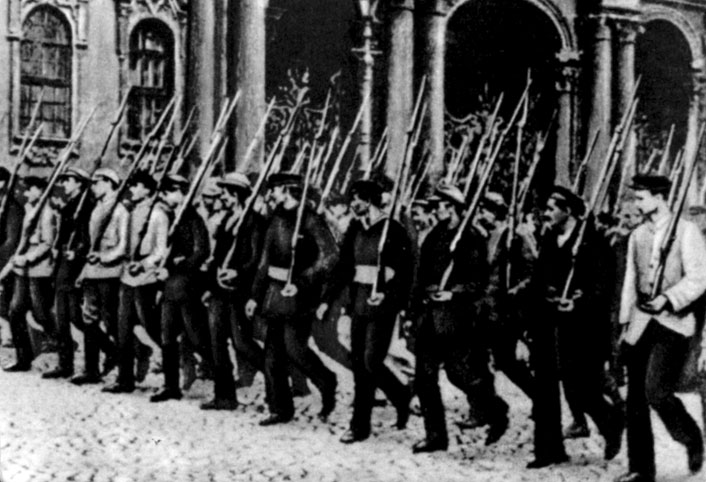Comparisons are being drawn between Russia’s internal conflict in WW1 and the present situation – the crisis was far more severe then than now
Jeffrey Sommers is Professor of Political Economy & Public Policy in the Department of African &African Diaspora Studies and a Senior Fellow, Institute of World Affairs, University of Wisconsin-Milwaukee. His book on the Baltics (with Charles Woolfson), is The Contradictions of Austerity: The Socio-economic Costs of the Neoliberal Baltic Model.
Cross-posted from Counterpunch

When news broke of Wagner Commander Yevgeny Prigozhin’s race toward Moscow this past weekend I noted in a social media post this required a serious logistical effort to supply. I have since scaled back my assessment of its logistical complexities. Rather than 24,000 Wagner forces on the march toward Moscow, it quickly became known it was only 4-6,000, and estimated vehicles at 55 on the bottom end, to 200 on the top side. Not insignificant, but not huge either. And we don’t know yet if it was Prigozhin’s intention of going all the way to Moscow, or if it was a bluff. In short, logistics may not have been that consequential for this rash dash to Moscow, or perhaps they were all along intending to halt before arriving there. There may, or may not, have been significant planning involved, but the logistical complexity of Prigozhin’s race to Moscow may not have required the advanced planning many pundits assert.
No sooner, however, had the tires on Prigozhin’s trucks stopped rolling, than pundits from what Vladimir Putin calls the “collective West” (as he terms what is chiefly the UK and its former historical settler colonies) were spinning yarns about how the run on Moscow reprised events of 1917. In fact, so was Putin for that matter. Having seemingly read an article or book on the subject, the foreign policy commentariat began churning out articles suggesting a veritable Kornilov Affair that was a prelude to the collapse of Russia’s Kerensky government still at war with Germany. Of course, it remains too early to tell if there are any “rhymes” let alone repetitions, to paraphrase the late Samuel Clemens to 1917, in this matter.
Regarding WWI, we all know it was catastrophic for Czarist and Kerensky’s Russia. Then 1.8 million Russian soldiers died and some half-million direct civilian deaths and another 700,000 from war related disease. Its economy shrank by over half. So, it was utter economic collapse then and some 2-3 million dead for Russia in 1917. This has little relation to Russia now, but that is hardly to say all is well there presently. But what are the differences between then and now?
Today, instead of over half of Russia’s GDP gone, Russia’s economy shrank 2.1% in 2022 and is set to grow by 0.7% this year. We might quibble at the margins of these numbers, but for most this is an unnoticeable change, vs the catastrophic collapse of Russia’s economy in WWI. Moreover, Russia presently is not even on a full war-economy footing (although their critics from Russian chauvinists say they should be). Russia is spending a paltry 3% of their GDP on the war. In short, Putin has undertaken his war in Ukraine on the cheap in hopes of “keeping the calm” at home. But it appears Putin went too far on this score of war without domestic inconvenience and the military and nationalists are unhappy with the results.
On deaths, the numbers are serious. Some tens of thousands (others argue more, but without conclusive evidence) Russian soldiers are dead. These are poor working-class sops from the provinces few care about. Disregard for their plight, if not fate, showed Putin at his worst when he told the mother of one of these fallen young men that she should be happy her son died for a reason. “Some people, are they even living or not living? It’s unclear. And how they die, from vodka or something else, it’s also unclear…But your son lived, you understand?” It’s rotten, but also increasingly normal in war today and Ukraine now also shows a similar profile for who is fighting and dying in this war.
This is all by way of saying we should not overstate comparisons with WWI, which while the present war is terrible, its impact still pales to that of the first World War. That said, the war clearly has gone on too long for the taste of Russia’s nationalists and they are restive with the lack of its progress. Thus, Putin will have to exit or escalate, both of which pose their dangers for the Kremlin, and possibly the world if Putin takes the likely path of escalation.
Thanks to many generous donors BRAVE NEW EUROPE will be able to continue its work for the rest of 2023 in a reduced form. What we need is a long term solution. So please consider making a monthly recurring donation. It need not be a vast amount as it accumulates in the course of the year. To donate please go HERE.


Be the first to comment